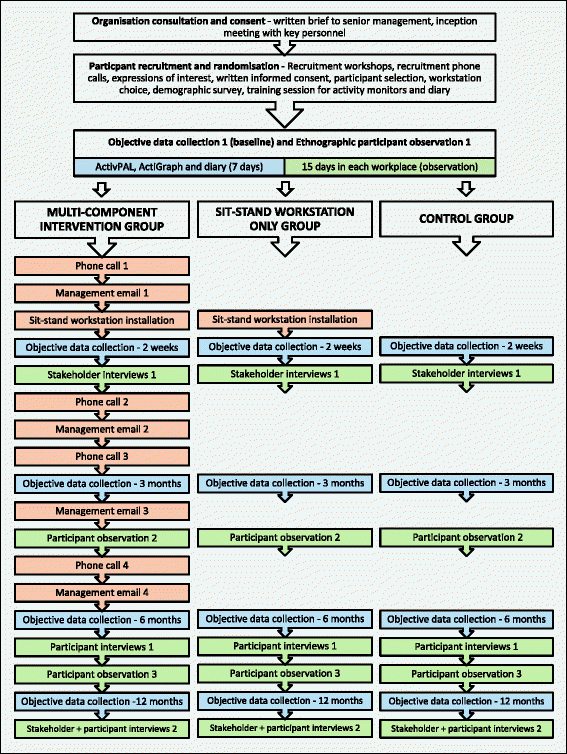The effect of a sit-stand workstation intervention on daily sitting, standing and physical activity: protocol for a 12 month workplace randomised control trial
- PMID: 25879905
- PMCID: PMC4336471
- DOI: 10.1186/s12889-015-1506-y
The effect of a sit-stand workstation intervention on daily sitting, standing and physical activity: protocol for a 12 month workplace randomised control trial
Abstract
Background: A lack of physical activity and excessive sitting can contribute to poor physical health and wellbeing. The high percentage of the UK adult population in employment, and the prolonged sitting associated with desk-based office-work, make these workplaces an appropriate setting for interventions to reduce sedentary behaviour and increase physical activity. This pilot study aims to determine the effect of an office-based sit-stand workstation intervention, compared with usual desk use, on daily sitting, standing and physical activity, and to examine the factors that underlie sitting, standing and physical activity, within and outside, the workplace.
Methods/design: A randomised control trial (RCT) comparing the effects of a sit-stand workstation only and a multi-component sit-stand workstation intervention, with usual desk-based working practice (no sit-stand workstation) will be conducted with office workers across two organisations, over a 12 month period (N = 30). The multicomponent intervention will comprise organisational, environmental and individual elements. Objective data will be collected at baseline, and after 2-weeks, 3-months, 6-months and 12-months of the intervention. Objective measures of sitting, standing, and physical activity will be made concurrently (ActivPAL3™ and ActiGraph (GT3X+)). Activity diaries, ethnographic participant observation, and interviews with participants and key organisational personnel will be used to elicit understanding of the influence of organisational culture on sitting, standing and physical activity behaviour in the workplace.
Discussion: This study will be the first long-term sit-stand workstation intervention study utilising an RCT design, and incorporating a comprehensive process evaluation. The study will generate an understanding of the factors that encourage and restrict successful implementation of sit-stand workstation interventions, and will help inform future occupational wellbeing policy and practice. Other strengths include the objective measurement of physical activity during both work and non-work hours.
Trail registration: Clinicaltrials.gov identifier NCT02172599, 22nd June 2014.
Figures
References
Publication types
MeSH terms
Associated data
LinkOut - more resources
Full Text Sources
Other Literature Sources
Medical


